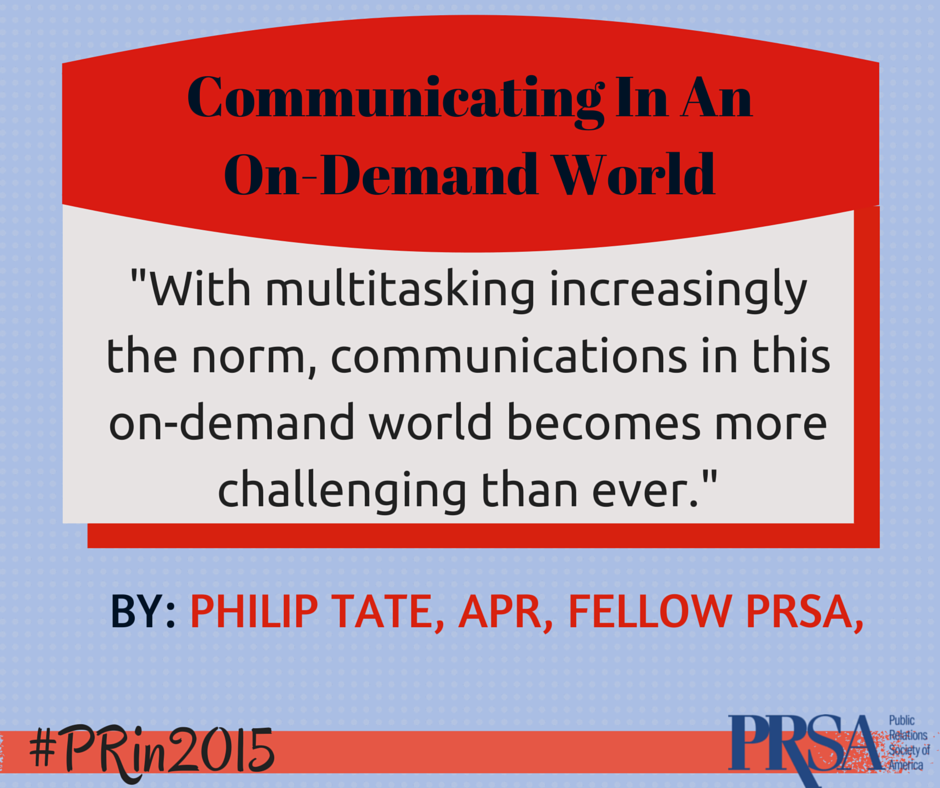For the third straight year, I’ve been asked to write a blog post about key trends in the public relations industry. Two years ago, I wrote about connecting the dots with content. Since then, content and storytelling have moved beyond emerging trends to become essential skills for every public relations professional.
In the most recent edition of his Cool Tech Tools enewsletter, Brandon Uttley, APR, former PRSA Charlotte Chapter president and CEO of Go for Launch, reinforced the ongoing importance of content: “One thing I will say for certain, content will still be extremely relevant for whatever you are trying to market this year. And it will still take work, yes work, sitting down to crank it out. There is no cool tool I know of that will adequately substitute for planting yourself in a chair and typing away.”
Last year, I focused on integrated marketing communications as the big picture strategy more PR practitioners are adopting to better meet evolving client demands.
In a recent column for American City Business Journals, Mike Crawford, president of M/C/C agency in Dallas, noted that integrated communications will still be on the rise in 2015. “Having your marketing, advertising and public relations teams all working together to create a cohesive brand message is the best way to communicate with your brand’s tailored audience. Messages should flow seamlessly from email campaigns to television advertisements to social media posts and graphics. Integrated communications allows marketers to repurpose content among all marketing communications vehicles.”
So the more things change, the more they stay the same, right? For 2015, I believe public relations practitioners must become more aware of communicating in an increasingly on-demand world. We know consumers are spending more time with media than ever before, but the way they access it continues to evolve. Television viewing remains on the rise but so does time spent on the internet. The 2015 edition of Advertising Age’s Marketing Fact Pack notes that watching TV remains by far the No. 1 leisure activity for Americans. The study also shows how TV viewers are multitasking with more than half of adults surfing the web on a computer or texting on a mobile phone while watching TV. All this confirms what many of us already knew based on our own behavior. With multitasking increasingly the norm, communications in this on-demand world becomes more challenging than ever.
So how do we combat the inherently shorter attention spans that accompany these trends? PR pros must remain up to date with the latest technology so we can recommend the best possible solutions. As Crawford noted in his column: “It’s important to remember that digital technology is evolving and not just a trend.”
Speaking of digital, how did social media change in 2014? While Twitter and Facebook remained dominant, new social networks rose to prominence. A few key data points from the Global Web Index:
- Tumblr and Pinterest were the fastest growing platforms and boast the youngest audiences.
- Snapchat is the fastest growing app in the mobile space – 56 percent growth in 2014 – and over-indexes with teens more strongly than any other app.
- YouTube has the highest visitation rate: 85 percent of online users visit each month; 6 billion hours of video is watched each month; and 100 hours of video is uploaded each minute.
The common thread remains content, whether it’s the strategy connecting it to business objectives or generating it to reach the desired audiences. Among the emerging on-demand channels are podcasts, which are having a moment right now. Exhibit A: the incredible popularity of Serial – a weekly podcast with more than 40 million downloads during its first season – from the creators of This American Life hosted by Sarah Koenig of WBEZ, the NPR member station in Chicago. Besides Serial, there are hundreds of highly popular podcasts, on topics ranging from sports and fashion to home repair and technology, which deliver content to loyal audiences who enjoy their favorites while commuting to work, running errands or exercising. Beyond podcasts that are essentially repurposed audio and video content for on-demand consumption, podcasting offers an opportunity for PR pros to deliver targeted content to very specific audiences.
“Podcasting is nonstop storytelling delivered in a regular series of conversations to engaged audiences,” said Steve Lubetkin, APR, Fellow PRSA, a former PRSA national board member and co-author, with Donna Papacosta of Trafalgar Communications, of the forthcoming book, The Business of Podcasting. “The recent renaissance in podcasting stems from access – it’s easier to get podcasts than ever before, regardless of device, whether you’re streaming or downloading.
“But podcasting is not just about getting downloads. It’s about getting focused self-selected audiences interested in what you have to say. For example, we produce podcasts for a global insurance company – conversations with subject matter experts in risk management. Those podcasts are part of an overall content marketing strategy, which uses social media as the megaphone to drive visitors to the website.
“Just remember, if a podcast doesn’t sound professional, it loses credibility. Take the time to script, record and edit your content to stay on brand and seek assistance as needed for quality videotaping or recording.” If you’re looking for more information on podcasting, contact Steve Lubetkin.
So what else should we anticipate in 2015? Use the comment section below to let us know what other emerging trends you see impacting the public relations industry.
Philip Tate, APR, Fellow PRSA is senior vice president at Luquire George Andrews (LGA) in Charlotte, N.C. He currently serves as chair elect of the PRSA College of Fellows and on the Board of Ethics and Professional Standards. He served on the PRSA national board of directors from 2008-2011, including two years as national treasurer (2010-2011). You can follow him on Twitter at @philiptater.







